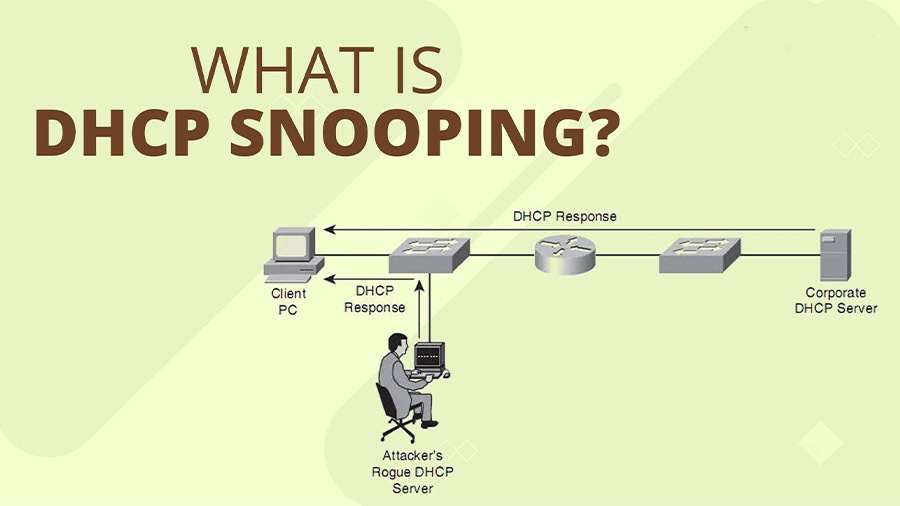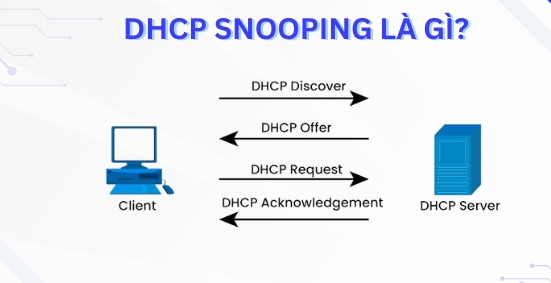What is DHCP Snooping? How to configure DHCP Snooping effectively

DHCP Snooping is a security technique in computer networks to prevent attacks related to the DHCP protocol. Let's learn in detail about how it works and its role in protecting your network from potential threats.
What is DHCP Snooping?
DHCP Snooping is a layer 2 security feature, similar to a firewall, built into the operating system of a network switch or router to enhance network security. It works by monitoring DHCP (Dynamic Host Configuration Protocol) traffic and classifying switch ports into trusted and untrusted ports.

What is DHCP Snooping?
This feature logs information about DHCP packets sent and received on the network, ensuring that only trusted DHCP servers can provide IP addresses to clients.
The Role of DHCP Snooping
DHCP Snooping plays a vital role in protecting your network from attacks. The roles of DHCP Snooping include:
- Protection against rogue DHCP servers: Identifying and blocking unauthorized DHCP servers helps protect clients from receiving erroneous settings that can cause disruption in the network.
- Monitor and log network information: DHCP Snooping also plays a role in logging information about DHCP requests and responses. Administrators can view the history of IP addresses assigned, thereby easily identifying potential problems in the network.
- Enhance overall network security: Unauthorized devices will be blocked from connecting, only valid devices can access network resources.
How does DHCP Snooping work?
DHCP Snooping acts as a monitor of DHCP traffic on the network, especially broadcast packets. When a device (client) requests an IP address, DHCP Snooping collects important data such as:
- Device MAC address
- The IP address it requires
- IP address lease time
It then compares this information with the data provided by a trusted DHCP server. If any discrepancy is detected, the IP assignment request is blocked and an alert is sent to the network administrator.
Attacks Prevented by DHCP Snooping
DHCP Snooping not only protects your network from rogue DHCP servers, but it can also prevent a number of other common attacks.
DHCP Spoofing Attack
A DHCP spoofing attack occurs when an attacker sets up a fake DHCP server on a network. The goal of this attack is to cause clients to connect to the fake server instead of the legitimate server. The attacker can then control IP addresses, change network configurations, and collect sensitive information from users.
DHCP Snooping prevents these attacks by not allowing unauthorized DHCP servers to send responses to DHCP requests. Only authenticated servers can interact with clients on the network, thus minimizing the possibility of attack.
DHCP Starvation Attack
DHCP crash attacks typically occur when an attacker attempts to exhaust all available IP addresses from a DHCP server. By sending many fake DHCP requests, an attacker can leave the DHCP server with no IP addresses to allocate to valid clients, resulting in a service disruption.
DHCP Snooping is capable of monitoring and logging DHCP requests, helping to detect unusual behavior.
How to configure DHCP Snooping?
Here are the general steps to configure DHCP Snooping on Cisco switches and routers:
- Enable DHCP Snooping Globally: Enable DHCP Snooping on the Cisco switch.
SW1(config)#ip dhcp snooping
- Enable DHCP Snooping for each VLAN: Enable DHCP Snooping for specific VLANs.
SW1(config)#ip dhcp snooping vlan 10
- Configure Trusted Ports: Define which ports are trusted
SW1(config)#interface FastEthernet0/1
SW1(config-if)#ip dhcp snooping trust
- DHCP Request Rate Limit Option:
SW1(config)# interface FastEthernet0/1
SW1(config-if)# ip dhcp snooping limit rate 20
- Verify DHCP Snooping: Check the status and bindings of DHCP Snooping.
SW1(config)# show ip dhcp snooping
SW1(config)# show ip dhcp snooping binding
Conclude
DHCP Snooping is an essential security feature that helps protect your network from attacks. By preventing rogue DHCP servers, it not only enhances security but also provides a stable network environment for connected devices.
As such, it can be seen that configuring and maintaining DHCP Snooping is also an important part of an overall network security strategy, helping administrators quickly identify and respond to potential threats.
You should read it
- Steps to fix 'Unable to Contact your DHCP Server' error on Windows 10
- What is DHCP or dynamic host configuration protocol?
- How to Install, Configure, and Test Windows Server 2012 R2 Single Subnet DHCP Server
- Set up DHCP server in Windows 2003
- The DHCP vulnerability in Red Hat Linux helps hackers execute remote code
- Which is better DHCP or static IP?
- Use Group Policy Filtering to create a NAP DHCP enforcement policy - Part 1
- Configuration, static DHCP settings on DD-WRT router
May be interested
- The DHCP vulnerability in Red Hat Linux helps hackers execute remote code
 security researchers at google have discovered a serious remote command-line vulnerability on red hat linux's dhcp software and derivative versions of the fedora operating system.
security researchers at google have discovered a serious remote command-line vulnerability on red hat linux's dhcp software and derivative versions of the fedora operating system. - Which is better DHCP or static IP?
 because there are limitations to static ips, some administrators seek to use dynamic ips instead. dhcp (dynamic host configuration protocol) is a protocol for dynamically assigning ip addresses to devices connected to a network. so dhcp vs static ip, what's the difference?
because there are limitations to static ips, some administrators seek to use dynamic ips instead. dhcp (dynamic host configuration protocol) is a protocol for dynamically assigning ip addresses to devices connected to a network. so dhcp vs static ip, what's the difference? - Use Group Policy Filtering to create a NAP DHCP enforcement policy - Part 1
 how to use group policy to control the implementation of dhcp network access policies, improves the level of performance so that dhcp can be enforced on nap clients.
how to use group policy to control the implementation of dhcp network access policies, improves the level of performance so that dhcp can be enforced on nap clients. - How to configure static IP address on Ubuntu 22.04 LTS and 22.10
 the ip addresses of most devices today are generated by the dynamic host configuration protocol (dhcp) server. the dhcp server dynamically assigns an ip address to your device when it is connected to the network. therefore, you have the opportunity to change this ip address from time to time.
the ip addresses of most devices today are generated by the dynamic host configuration protocol (dhcp) server. the dhcp server dynamically assigns an ip address to your device when it is connected to the network. therefore, you have the opportunity to change this ip address from time to time. - Turn a dead bird into a drone to improve snooping
 researchers have launched a project to incorporate dead birds into drones to help improve future ways of snooping and tracking wildlife.
researchers have launched a project to incorporate dead birds into drones to help improve future ways of snooping and tracking wildlife. - Instructions on DD-WRT - Part 1: Static DHCP
 there are many cases where you want your client to receive a consistent or predictable ip address.
there are many cases where you want your client to receive a consistent or predictable ip address. - Learn about DHCP Server Security (part 2)
 in this part 2, we will continue with the effective methods and tools used to enhance the security of the dhcp server.
in this part 2, we will continue with the effective methods and tools used to enhance the security of the dhcp server. - How to configure TCP/IP using CMD command on Windows
 configuring tcp/ip with cmd commands helps network administrators easily control ip, dns and dhcp settings without a graphical interface. netsh is a powerful tool that supports network connection management, system optimization and quick troubleshooting.
configuring tcp/ip with cmd commands helps network administrators easily control ip, dns and dhcp settings without a graphical interface. netsh is a powerful tool that supports network connection management, system optimization and quick troubleshooting. - Use Group Policy Filtering to create a DHCP enforcement policy for NAP - Part 3
 in this part 3, i will show you more about policies and see what they do in a dhcp enforcement solution.
in this part 3, i will show you more about policies and see what they do in a dhcp enforcement solution. - Instructions for installing DHCP Role in Windows Server 2012
 dynamic host configuration protocol (dhcp) - dynamic server configuration protocol is the network services that are commonly deployed in the current network environment
dynamic host configuration protocol (dhcp) - dynamic server configuration protocol is the network services that are commonly deployed in the current network environment










 What is Logic Bomb? How to Prevent Logic Bomb Effectively
What is Logic Bomb? How to Prevent Logic Bomb Effectively What is OCSP (Online Certificate Status Protocol)? Advantages and disadvantages of OCSP
What is OCSP (Online Certificate Status Protocol)? Advantages and disadvantages of OCSP How to completely remove W32.UsbFakeDrive Virus on computer and USB
How to completely remove W32.UsbFakeDrive Virus on computer and USB How to use Malwarebytes Anti-Malware to scan and remove malware
How to use Malwarebytes Anti-Malware to scan and remove malware What is Reflected XSS? How to know if you are attacked by Reflected XSS
What is Reflected XSS? How to know if you are attacked by Reflected XSS What is Smurf Attack? How to prevent Smurf Attack?
What is Smurf Attack? How to prevent Smurf Attack?